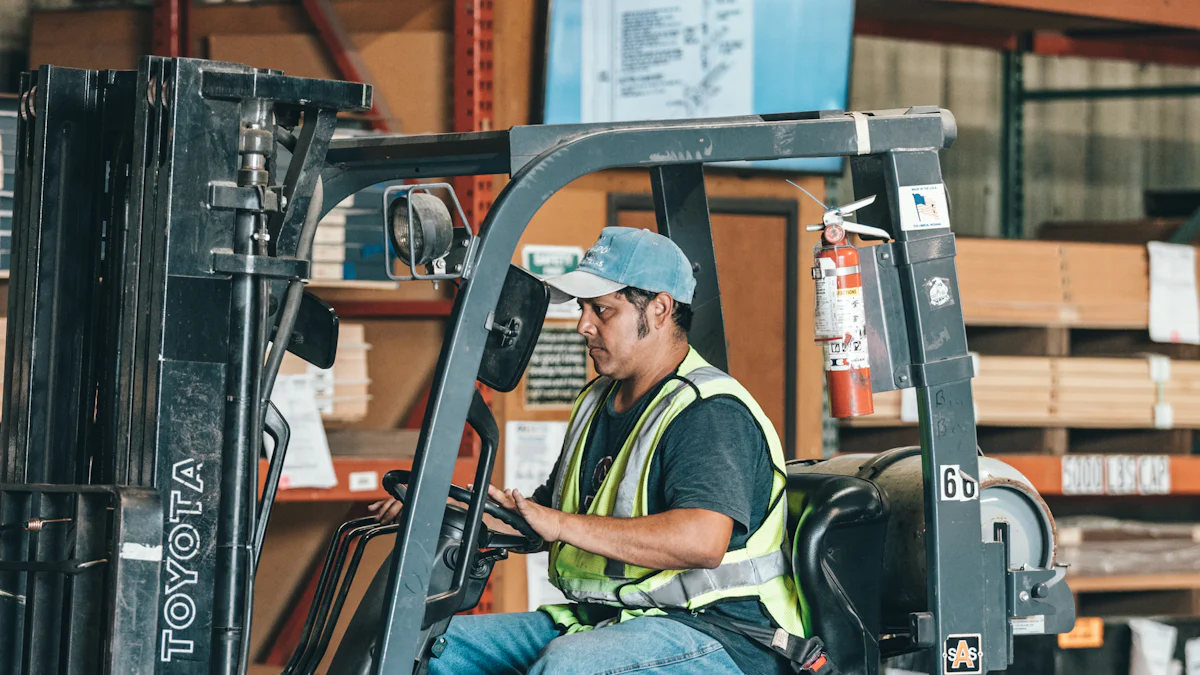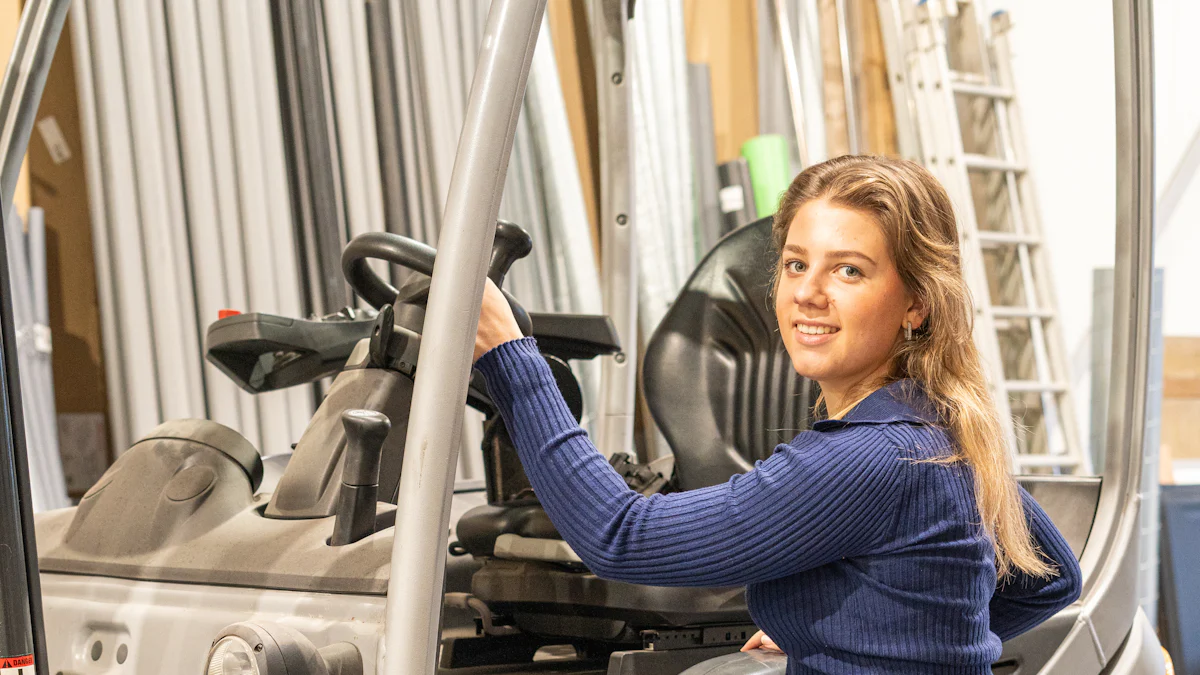
Stand-up electric forklifts with a Pallet Jack are a vital asset in the realm of material handling, offering unique advantages in specific operational scenarios. Understanding these machines is crucial for optimizing warehouse efficiency and safety. Comparatively, sit-down forklifts serve as formidable counterparts, excelling in different aspects of functionality. Delving into the distinctions between these two types unveils a world of possibilities for businesses seeking tailored solutions to their logistical challenges.
Definition and Overview
What is a Stand-Up Electric Forklift?
Basic Definition
Stand-up forklifts, also known as Stand Up Forklifts, are designed to offer better visibility and agility in operational environments. These forklifts excel in tasks that require frequent stops and starts or maneuvering in narrow spaces. They come in various configurations, including Stand Up Counterbalance Forklifts, Stand Up Reach Forklifts, and Stand Up Order Picker Forklifts.
Key Features
- Exceptional Maneuverability: Stand-up electric forklifts are renowned for their outstanding maneuverability, allowing operators to navigate tight spaces with ease.
- Versatile Configurations: With different types available, these forklifts cater to a wide range of operational needs.
- Compact Design: Their shorter and more compact build makes them ideal for confined spaces where larger forklifts might struggle to operate efficiently.
- Tight Turning Radius: The design of stand-up electric forklifts enables a tight turning radius, enhancing their ability to maneuver in challenging layouts.
Features Comparison

Stand-Up Electric Forklift Features
Maneuverability
- Stand-up electric forklifts are specifically designed to operate in narrow aisles.
- Their compact size and maneuverability allow them to navigate tight spaces with ease, maximizing the utilization of available storage areas.
Space Efficiency
- Stand-up electric forklifts excel in space utilization, especially in warehouses with narrow aisles.
- Their compact design allows for tighter turning radii, enabling efficient maneuvering in confined spaces.
Sit-Down Forklift Features
Operator Comfort
- A sit-down forklift often has a wider wheelbase and a larger turning radius than other forklift designs, making them difficult to operate efficiently in small spaces.
Load Capacity
- With their smaller turning ratios and maneuverability, a stand-up electric forklift may be the better choice in space-constrained environments or those with narrow aisles.
Benefits and Drawbacks
Benefits of Stand-Up Electric Forklifts
Enhanced Visibility
- Stand-up electric forklifts offer enhanced visibility in operational environments, allowing operators to navigate with precision and awareness.
Quick Entry and Exit
- Operators can swiftly enter and exit stand-up electric forklifts, enhancing efficiency during tasks that require frequent stops.
Drawbacks of Stand-Up Electric Forklifts
Operator Fatigue
- Prolonged use of stand-up electric forklifts may lead to operator fatigue due to the need for constant standing and maneuvering.
Limited Load Capacity
- Stand-up electric forklifts have a limited load capacity ranging from 3,000 to 4,000 lbs, which may restrict their suitability for heavy-duty applications.
Benefits of Sit-Down Forklifts
Operator Comfort
- Sit-down forklifts prioritize operator comfort with a wider wheelbase and increased stability, ensuring a more comfortable working experience.
Higher Load Capacity
- With a higher load capacity compared to stand-up models, sit-down forklifts are ideal for handling heavier loads efficiently.
Drawbacks of Sit-Down Forklifts
Larger Turning Radius
- Sit-down forklifts are hindered by a larger turning radius, limiting their agility in navigating through tight spaces efficiently.
- The increased turning radius of sit-down forklifts poses challenges in confined areas where precise maneuvering is essential for operational productivity.
- This limitation can lead to delays in material handling tasks and potentially impact overall warehouse efficiency.
Requires More Space
- Sit-down forklifts demand more operating space due to their design, which can be a significant drawback in warehouses with limited room for maneuvering.
- The requirement for additional space can restrict the flexibility and adaptability of sit-down forklifts in dynamic warehouse environments.
- This constraint may result in suboptimal space utilization and hinder the seamless flow of materials within the facility.
Choosing the Right Forklift

Factors to Consider
Warehouse Space
- Warehouse Space plays a crucial role in determining the suitability of a forklift type for operational efficiency.
- The availability of ample space allows for seamless navigation and maneuvering of stand-up electric forklifts or Pallet Jacks within the warehouse environment.
- Limited warehouse space may necessitate the use of compact and agile equipment like stand-up electric forklifts to optimize storage utilization.
Type of Loads
- Considering the Type of Loads is essential when selecting between stand-up and sit-down forklifts.
- Stand-up electric forklifts are ideal for handling lighter loads efficiently, making them suitable for applications that involve frequent loading and unloading tasks.
- Sit-down forklifts, on the other hand, excel in managing heavier loads with stability and precision, enhancing productivity in operations requiring substantial lifting capacities.
Application Scenarios
Ideal for Stand-Up Forklifts
- Stand-Up Forklifts are particularly well-suited for environments where operators need to frequently embark and disembark from the equipment.
- These forklifts shine in scenarios that demand quick entry and exit capabilities, enhancing operational speed and agility.
- The compact design of stand-up electric forklifts enables seamless maneuvering in confined spaces, making them an optimal choice for warehouses with narrow aisles.
Ideal for Sit-Down Forklifts
- Sit-down forklifts offer advantages in applications where operator comfort and stability are paramount considerations.
- In scenarios requiring prolonged operation or handling heavy loads, sit-down models provide ergonomic seating arrangements that reduce operator fatigue.
- Sit-down forklifts excel in environments with more generous operating spaces, allowing operators to navigate smoothly while maintaining control over larger loads.
Warehouse Managers emphasize the pivotal role of stand-up forklifts in warehouse operations. These forklifts excel in tasks like loading trucks, moving pallets, and stacking inventory efficiently. Their agility in navigating narrow aisles and confined spaces enhances material handling in bustling distribution centers. When choosing between stand-up and sit-down forklifts, assessing specific operational needs is paramount. Tailoring the choice to match the demands of the environment ensures optimal efficiency and safety in daily warehouse operations.
Post time: Jun-24-2024
